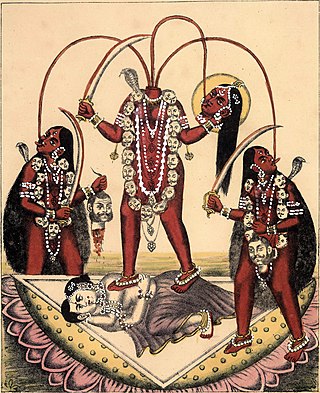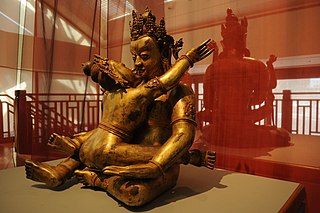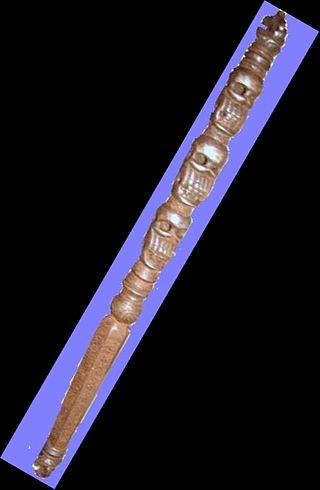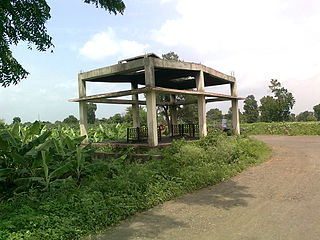
Tantra is an esoteric yogic tradition that developed on the Indian subcontinent from the middle of the 1st millennium CE onwards in both Hinduism and Buddhism.

Chhinnamasta, often spelled Chinnamasta, and also called Chhinnamastika and Prachanda Chandika and Jogani Maa, is a Hindu goddess (Devi). She is one of the Mahavidyas, ten goddesses from the esoteric tradition of Tantra, and a ferocious aspect of Mahadevi, the Hindu Mother goddess. The self-decapitated nude goddess, usually standing or seated on a divine copulating couple, holding her own severed head in one hand and a scimitar in another. Three jets of blood spurt out of her bleeding neck and are drunk by her severed head and two attendants.
Tantras in Hinduism are esoteric scriptures.

Tantric sex or sexual yoga refers to a range of practices in Hindu and Buddhist tantra that utilize sexuality in a ritual or yogic context. Tantric sex is associated with antinomian elements such as the consumption of alcohol, and the offerings of substances like meat to deities. Moreover, sexual fluids may be viewed as power substances and used for ritual purposes, either externally or internally.

In the Shaivism and Shaktism tradition of Hinduism, the goddess Tara is the second of the ten Mahavidyas. She is considered a form of Adishakti, the tantric manifestation of Parvati. Her three most famous forms are Ekajaṭā, Ugratara, and Nīlasarasvatī. Her most famous centre of worship is the temple and the cremation ground of Tarapith in West Bengal, India.

In Buddhism, wrathful deities or fierce deities are the fierce, wrathful or forceful forms of enlightened Buddhas, Bodhisattvas or Devas ; normally the same figure has other, peaceful, aspects as well. Because of their power to destroy the obstacles to enlightenment, they are also termed krodha-vighnantaka, "Wrathful onlookers on destroying obstacles". Wrathful deities are a notable feature of the iconography of Mahayana and Vajrayana Buddhism, especially in Tibetan art. These types of deities first appeared in India during the late 6th century, with its main source being the Yaksha imagery, and became a central feature of Indian Tantric Buddhism by the late 10th or early 11th century.

Bhairava, or Kala Bhairava, is a Shaivite and Vajrayāna deity worshipped by Hindus and Buddhists. In Shaivism, he is a powerful manifestation, or avatar, of Shiva, associated with annihilation. In the tradition of Kashmir Shaivism, Bhairava represents the Supreme Reality, synonymous to Para Brahman. Generally in Hinduism, Bhairava is also called Dandapani, as he holds a rod or danda to punish sinners, and Svaśva, meaning, "he whose vehicle is a dog". In Vajrayana Buddhism, he is considered a fierce emanation of boddhisatva Mañjuśrī, and also called Heruka, Vajrabhairava, and Yamantaka.

Buddhism includes a wide array of divine beings that are venerated in various ritual and popular contexts. Initially they included mainly Indian figures such as devas, asuras and yakshas, but later came to include other Asian spirits and local gods. They range from enlightened Buddhas to regional spirits adopted by Buddhists or practiced on the margins of the religion.

Yamāntaka or Vajrabhairava is the "destroyer of death" deity of Vajrayana Buddhism. Sometimes he is conceptualized as "conqueror of the lord of death". Of the several deities in the Buddhist pantheon named 'Yamāntaka', the most well known, also called as 'Vajrabhairava' belongs to the Anuttarayoga Tantra class of deities popular within the Gelug school of Tibetan Buddhism.

A ḍākinī is a type of female spirit, goddess, or demon in Hinduism and Buddhism.

The Cakrasaṃvara Tantra is an influential Buddhist Tantra. It is roughly dated to the late 8th or early 9th century by David B. Gray. The full title in the Sanskrit manuscript used by Gray's translation is: Great King of Yoginī Tantras called the Śrī Cakrasaṃvara (Śrīcakrasaṃvara-nāma-mahayoginī-tantra-rāja). The text is also called the Discourse of Śrī Heruka (Śrīherukābhidhāna) and the Samvara Light (Laghusaṃvara).

Mahākāla is a deity common to Hinduism and Buddhism.

A ganacakra is also known as tsok, ganapuja, cakrapuja or ganacakrapuja. It is a generic term for various tantric assemblies or feasts, in which practitioners meet to chant mantra, enact mudra, make votive offerings and practice various tantric rituals as part of a sādhanā, or spiritual practice. The ganachakra often comprises a sacramental meal and festivities such as dancing, spirit possession, and trance; the feast generally consisting of materials that were considered forbidden or taboo in medieval India like meat, fish, and wine. As a tantric practice, forms of gaṇacakra are practiced today in Hinduism, Bön and Vajrayāna Buddhism.

Vajrayoginī is an important figure in Buddhism, especially revered in Tibetan Buddhism. In Vajrayana she is considered a female Buddha and a ḍākiṇī. Vajrayoginī is often described with the epithet sarvabuddhaḍākiṇī, meaning "the ḍākiṇī [who is the Essence] of all Buddhas". She is an Anuttarayoga Tantra meditational deity (iṣṭadevatā) and her practice includes methods for preventing ordinary death, intermediate state (bardo) and rebirth (samsara) by transforming them into paths to enlightenment, and for transforming all mundane daily experiences into higher spiritual paths.

A khaṭvāṅga is a long, studded club originally created as a weapon. It was adopted as a traditional religious symbol in Indian religions such as Tantric traditions like Shaivism and Vajrayana Buddhism. The khatvāṅga was adopted by some lineages of historical tantra though it preceded such traditions as of an original tribal shaman shaft.

A kapala is a skull cup used as a ritual implement (bowl) in both Hindu Tantra and Buddhist Tantra (Vajrayana). Especially in Tibet, they are often carved or elaborately mounted with precious metals and jewels.

Kali or Kalika is a major Hindu goddess associated with time, change, creation, power, destruction and death in Shaktism. Kali is the first of the ten Mahavidyas in the Hindu tantric tradition.

A charnel ground is an above-ground site for the putrefaction of bodies, generally human, where formerly living tissue is left to decompose uncovered. Although it may have demarcated locations within it functionally identified as burial grounds, cemeteries and crematoria, it is distinct from these as well as from crypts or burial vaults.

A śmaśāna is a Hindu crematory ground, where dead bodies are brought to be burnt on a pyre. It is usually located near a river or body of water on the outskirts of a village or town; as they are usually located near river ghats they are also called smashan ghat.

Mundamala, also called kapalamala or rundamala, is a garland of severed human heads and/or skulls, in Hindu iconography and Tibetan Buddhist iconography. In Hinduism, the mundamala is a characteristic of fearsome aspects of the Hindu Divine Mother and the god Shiva; while in Buddhism, it is worn by wrathful deities of Tibetan Buddhism.




















